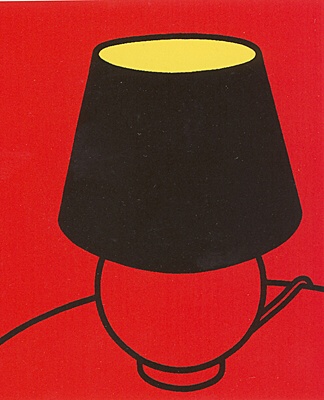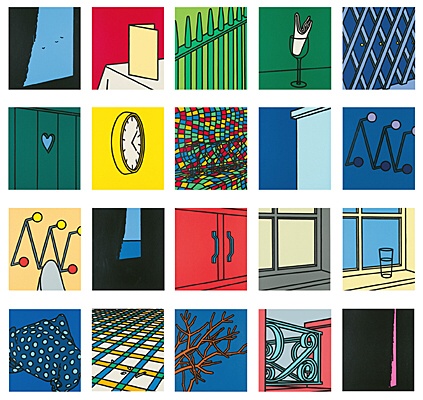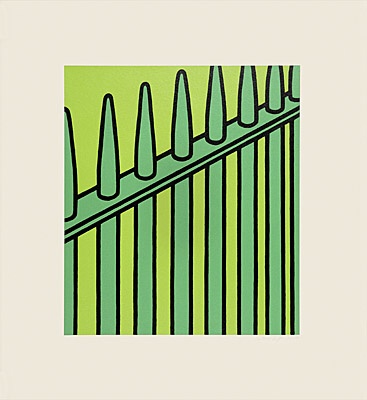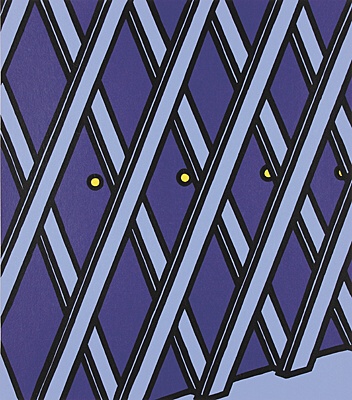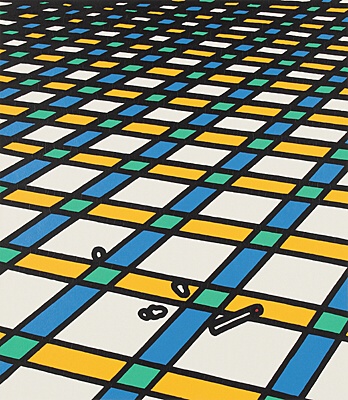We cordially invite you to a virtual tour of our exhibition "BOISSERÉE GOES POP":
Patrick Caulfield
Patrick Caulfield (London 1936–2005 London) is one of those painters who were particularly reluctant to use the term Pop Art in connection with their work. Yet despite his resistance to any categorisation, his themes, motifs and pictorial methods resulted in permanently valid icons of British Pop Art.
Formal considerations were Caulfield’s primary concern. They concentrate on the relationship between a clearly defined form and a strong, nuance-free colour. Some objects refer to other art styles and genres, recalling Vermeer, Caspar David Friedrich, Mondrian, Duchamp, Magritte and Constable. He was particularly fond of the Cubist Juan Gris.
Caulfield was a master of visual illusions. The things and spaces depicted so simply are full of allusions and innuendos, humour and melancholy.
From 1956 to 1960, Caulfield studied at the Chelsea School of Art, and from 1960 to 1963 at the Royal College of Art in London, together with David Hockney and R. B. Kitaj. While still a student, he took part in the Young Contemporaries exhibition in London in 1961. After completing his studies, he returned to the Chelsea School of Art as a university lecturer from 1963 to 1971. In 1964, he was one of the artists who took part in the Pop Art exhibition New Generation at the Whitechapel Gallery in London. Since then, his work has been presented in numerous British and international exhibitions.
Patrick Caulfield (London 1936 – 2005 London)
"Ah! until nature has pity on us,
I’ll take my life monotonous."
"She left yesterday. Perhaps I mind?
Ah yes! So that’s what hurts!"
Jules Laforgue
Patrick Caulfield is one of those painters who did not like it when the term Pop Art was used in connection with their work. But despite his resistance to any categorisation,
his themes and motifs, as well as his artistic methods, resulted in lastingly relevant icons of British Pop Art.
Born in London in 1936 and deceased there in 2005, he studied at the Chelsea School of Art from 1956 to 1960 and, together with David Hockney and R. B. Kitaj, at the
Royal College of Art in London from 1960 to 1963. While still a student, he participated in the Young Contemporaries exhibition in London in 1961. After completing
his studies, he returned to the Chelsea School of Art as a lecturer from 1963 to 1971. In 1964, he was one of the artists who participated in the Pop Art exhibition
New Generation at the Whitechapel Gallery in London. Since then, his work has been presented in numerous British and international exhibitions.
In 1964, Caulfield produced his first prints. Over the years, they became increasingly reduced, schematic and direct. Formal considerations were his primary concern.
They focus on the relationship between a clearly defined form and a strong, nuance-free colour. In his efforts to make a formal solution which otherwise might have
seemed rather hermetic more easily accessible, he appropriated imagery from the world around him.
Printmaking became an essential form of expression for him.
Caulfield was a master of visual illusion. The objects and rooms depicted so simply are full of innuendos and allusions. Caulfield found a kindred spirit in
Jules Laforgue (Montevideo 1860 – 1887 Paris). Witty, ironic and full of melancholy, Laforgue described in his texts, poems and stories the small, simple things
of everyday life, the mundane circumstances of daily life.
The edition on view in the exhibition, Some Poems of Jules Laforgue (1973), contains twenty-two prints by Patrick Caulfield and twelve poems by Jules Laforgue.
The bibliophile books in English or French are supplemented by signed individual pages from special editions of the respective book.
The lamps and windows, the abandoned restaurants in their sharp-angled geometry of light and shadow, the slightly open curtains, the empty coat stands and flower
vases make visible what is not visible. They tell of happiness and sorrow, of rendezvous that have taken place or not been kept, of a zest for life or loneliness.
In their isolation, the objects and motifs are testimony to their own selves.
